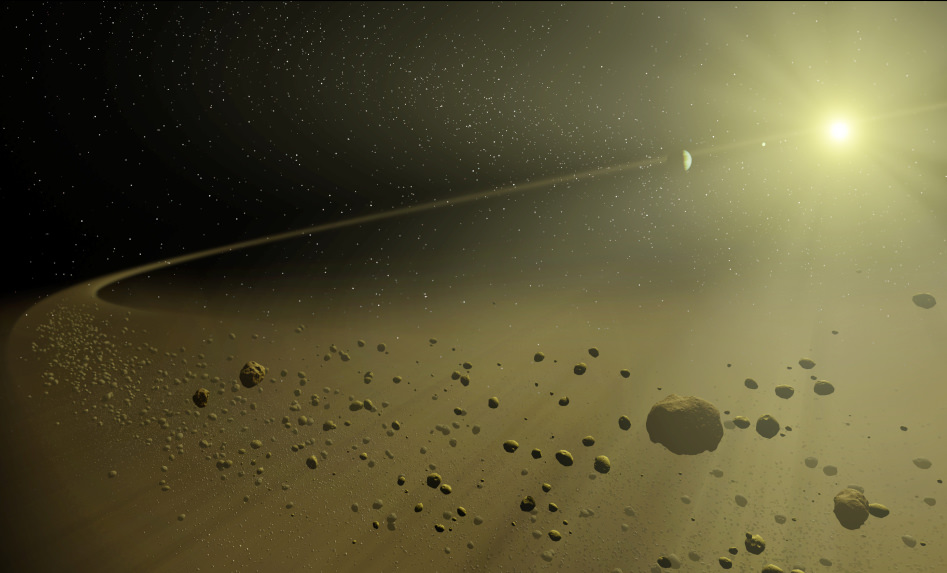Universe Today | Steve Nerlich | 2011 Apr 09
Debris disks as signposts of terrestrial planet formation - SN Raymond et alRecent modeling of solar mass stars with planetary systems, found that a system with four rocky planets and four gas giants in stable orbits – and only a sparsely populated outer belt of planetesimals – has only a 15 to 25% likelihood of developing. While you might be skeptical about the validity of a model that puts our best known planetary system in the unlikely basket, there may be some truth in this finding.
- [size=85][i]The Moon has retained a comprehensive record of the Late Heavy Bombardment from 4.1 to 3.8 billion years ago - resulting from a reconfiguration of the gas giants. As well as clearing out much of debris disk of the early Solar System, this reconfiguration flung material into the inner solar system to bombard the rocky planets.[/i][/size]
This modeling has been informed by the current database of known exoplanets and otherwise based on some prima facie reasonable assumptions. Firstly, it is assumed that gas giants are unable to form within the frost line of a system – a line beyond which hydrogen compounds, like water, methane and ammonia would exist as ice. For our Solar System, this line is about 2.7 astronomical units from the Sun – which is roughly in the middle of the asteroid belt.
Gas giants are thought to only be able to form this far out as their formation requires a large volume of solid material (in the form of ices) which become then become the cores of the gas giants. While there may be just as much rocky material like iron, nickel and silicon outside the frost line, these materials are not abundant enough to play a significant role in forming giant planets and any planetesimals they may form are either gobbled up by the giants or flung out of orbit.
However, within the frost line, rocky materials are the dominant basis for planet forming – since most light gas is blown out of the region by force of the stellar wind and other light compounds (such as H2O and CO2) are only sustained by accretion within forming planetesimals of heavier materials (such as iron, nickel and silicates). Appreciably-sized rocky planets would probably form in these regions within 10-100 million years after the star’s birth.
So, perhaps a little parochially, it is assumed that you start with a system of three regions – an inner terrestrial planet forming region, a gas giant forming region and an outer region of unbound planetesimals, where the star’s gravity is not sufficient to draw material in to engage in further accretion.
From this base, Raymond et al ran a set of 152 variations, from which a number of broad rules emerged. Firstly, it seems that the likelihood of sustaining terrestrial inner planets is very dependent on the stability of the gas giants’ orbits. Frequently, gravitational perturbations amongst the gas giants results in them adopting more eccentric elliptical orbits which then clears out all the terrestrial planets – or sends them crashing into the star. Only 40% of systems retained more than one terrestrial planet, 20% had just one and 40% had lost them all.
Debris disks of hot and cold dust were found to be common phenomena in matured systems which did retain terrestrial planets. In all systems, primal dust is largely cleared out within the first few hundred million years – by radiation or by planets. But, where terrestrial planets are retained, there is a replenishment of this dust – presumably via collisional grinding of rocky planetesimals.
This finding is reflected in the paper’s title Debris disks as signposts of terrestrial planet formation. If this modeling work is an accurate reflection of reality, then debris disks are common in systems with stable gas giants – and hence persisting terrestrial planets – but are absent from systems with highly eccentric gas giant orbits, where the terrestrial planets have been cleared out.
Nonetheless, the Solar System appears as unusual in this schema. It is proposed that perturbations within our gas giants’ orbits, leading to the Late Heavy Bombardment, were indeed late with respect to how other systems usually behave. This has left us with an unusually high number of terrestrial planets which had formed before the gas giant reconfiguration began. And the lateness of the event, after all the collisions which built the terrestrial planets were finished, cleared out most of the debris disk that might have been there – apart from that faint hint of Zodiacal light that you might notice in a dark sky after sunset or before dawn.
- arXiv.org > astro-ph > arXiv:1104.0007 > 31 Mar 2011

